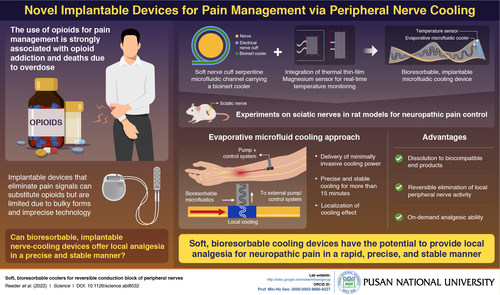Researchers test the efficacy of a soft, bioresorbable, implantable device to block pain signals from sciatic nerves of rat models
BUSAN, South Korea, Sept. 7, 2022 /PRNewswire/ — Owing to their high efficacy, opioids are used widely for the management of neuropathic pain, despite the increasing rates of opioid addiction and deaths due to overdose. To avoid these side effects, there is an urgent need for pain management approaches that can substitute opioid use.
It is well known that cold temperatures numb the sensation in our nerves. Evidence suggests that cooling peripheral nerves can in fact reduce the velocity and amplitude of neural signals that cause pain, leading to pain relief. What’s great about this approach is that if made possible, it will be completely reversible and non-addictive.
To this end, a team of researchers led by Professor Min-Ho Seo from Pusan National University developed a soft, bioresorbable, implantable device with the potential to cool peripheral nerves in a minimally invasive, focused manner. “Scientists already knew that low temperatures could numb the nerves in the body. But demonstrating this phenomenon with a small device at a clinical level was not an easy task,” said Prof. Seo while discussing the study, which was published in Volume 377 Issue 6601 of Science on June 30, 2022.
To develop the device, the team designed a microfluidics system formed with a bioresorbable material—poly(octanediol citrate)—with interconnects carrying a liquid coolant to a serpentine chamber. To top it off, a Magnesium temperature sensor for real-time temperature monitoring was incorporated at its distal end. The intensity and localization of the cooling effect was regulated by perfluoro pentane (PFP) and dry nitrogen gas (N2)—the two components of the liquid coolant, as well as the geometry of the serpentine chamber.
Next, the team tested the device by implanting it into the sciatic nerves of living rat models with neuropathic pain associated with spared nerve injury. After a three-week evaluation, the team found that the device successfully delivered cooling power to the peripheral nerves of the rats, which led to a reduction in their pain. Fortunately, the delivery of the cooling power occurred in a minimally invasive, stable, and precise manner. What’s more, this application was localized and reversible, and remained effective for almost 15 minutes during one session.
On being submerged in phosphate-buffered saline solution at 75°C, the device, which was made of bioresorbable materials, dissolved within 20 days and got eliminated in approximately 50 days. These findings imply that it has the potential to naturally degrade and get resorbed in the human body.
So, what are the future applications of this device? “The developed device can be used to treat pain after surgery. Since it is connected to an external source of fluid and power like a commercial intravenous (IV) device, it can easily be controlled by the patient. This way, our implantable device will be able to provide targeted and individualized relief without the drawbacks of the addictive pain medications,” said Prof. Seo in response.
With such progress underway, patients with neuropathic pain will finally be able to receive safe and sustainable treatment, without the risk of adverse effects associated with opioid use!
DOI: https://doi.org/10.1126/science.abl8532
Title of original paper: Soft, bioresorbable coolers for reversible conduction block of
peripheral nerves
Journal: Science
Your Press Release Source
Pusan National University
About Pusan National University
Website: https://www.pusan.ac.kr/eng/Main.do
About Assistant Professor Min-Ho Seo
Lab website: http://sites.google.com/view/mhseogroup
ORCID ID: Prof. Min-Ho Seo:0000-0002-9990-9227
Jae-Eun Lee
82 51 510 7928
343957@email4pr.com
SOURCE Pusan National University


